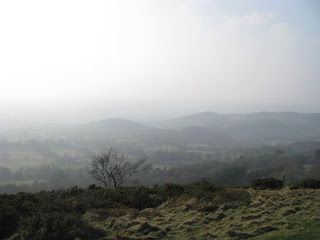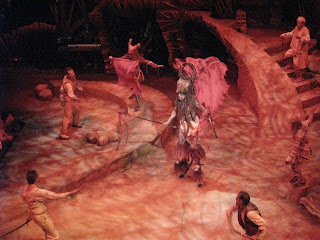Still, we have a lot planned in that time. Our senior seminar on the history of western civilization is entering rather rough, deep waters under the lowering skies of modernity (having just finished Nietzsche, Weber, Heidegger, and Arendt, we're on to Dickinson, Kafka, Welles, and Camus in the next few weeks) just as the warming air lulls us out of doors. And soon (following our return from the thesis writers' final break), we'll be hosting a farewell Open House for all our friends here in Oxford: tutors, landlords, housemates and neighbors, the staff at the Turf, and just plain friends. Of course, we'll be sure to invite the housing staff and porters at New College. They've been generous with their rooms in college all year, and for the Open House, they're lending us their Long Room, a medieval hall overlooking Queen's Lane. Those taking music tutorials are planning performances - on the piano, lute, guitar, violin, in song, and (if I can persuade others) some poetry recitals. And, to be sure, we'll be feeding the festivity with our own fare, as we've been doing lately (see Kim's post below - all of which makes me wonder if we've ever had a student do a cooking tutorial . . . ). Then, there are many of us planning last trips before returning to the states in late April and May.

 But even with all this ahead of us, for days to remember it will be hard to top last Saturday. We went up to Great Malvern, about an hour and a half northwest of Oxford by train. The town perches at the upper end and lower slopes of the Malvern Hills, a chain of high bald beacons that runs southeast toward Wales just west of the Severn River. We had plans to climb the highest of these, the Worcester Beacon, after stopping in town to take in the 15th-century stained glass at the Priory. There, we found that in addition to the glass (which was magnificient despite being generally decayed and thus oddly empty in places) the Priory had other treasures. Most interesting to me were its misericords, which also date to the 15th century. The misericord is a "mercy seat" for those having to stand for long hours in the choir stalls during services. The seat itself tips up for the sitter to perch on (and thus appear to be still standing), and most are carved on the underside so that once up they reveal sometimes startlingly comic and bawdy scenes from folklore of a decidely non-sacred bent. Here, I offer a photo of one that I have no explanation or source for except that its neighbor depicted a medieval doctor taking a urine sample from his bedridden patient. Most misericords aren't quite so broadly comic. (At least I hope this is supposed to be comic; and I apologize if anyone's offended, but I find myself delighting in these eruptions of the everyday and often brazenly profane medieval imagination into the otherwise otherworldliness of the gothic. Think Chaucer, I guess, or Piers Plowman, which has the Malvern hills as its opening setting).
But even with all this ahead of us, for days to remember it will be hard to top last Saturday. We went up to Great Malvern, about an hour and a half northwest of Oxford by train. The town perches at the upper end and lower slopes of the Malvern Hills, a chain of high bald beacons that runs southeast toward Wales just west of the Severn River. We had plans to climb the highest of these, the Worcester Beacon, after stopping in town to take in the 15th-century stained glass at the Priory. There, we found that in addition to the glass (which was magnificient despite being generally decayed and thus oddly empty in places) the Priory had other treasures. Most interesting to me were its misericords, which also date to the 15th century. The misericord is a "mercy seat" for those having to stand for long hours in the choir stalls during services. The seat itself tips up for the sitter to perch on (and thus appear to be still standing), and most are carved on the underside so that once up they reveal sometimes startlingly comic and bawdy scenes from folklore of a decidely non-sacred bent. Here, I offer a photo of one that I have no explanation or source for except that its neighbor depicted a medieval doctor taking a urine sample from his bedridden patient. Most misericords aren't quite so broadly comic. (At least I hope this is supposed to be comic; and I apologize if anyone's offended, but I find myself delighting in these eruptions of the everyday and often brazenly profane medieval imagination into the otherwise otherworldliness of the gothic. Think Chaucer, I guess, or Piers Plowman, which has the Malvern hills as its opening setting). One other thing we discovered at the Malvern Priory was the apparent inspiration for the early passage in The Lion, the Witch and the Wardrobe by C.S. Lewis (a student in Malvern once upon a time) in which Lucy enters Narnia through the back of an old wardrobe after seeing a gas light shining through a small hole. Here's my best shot of what purports to be that very hole and gaslight (one of those which do march, oddly, right up into the woods out of town, just as in the books). The hole here is for the key to the back door of the Priory itself, which looks out onto a grassy lane toward the market square. So, here we were walking off into a fantastical Christian allegory, rather than Worcestershire, as we'd thought.
 But first, we lounged (not for the first or last time) in the cemetery outside, where Darwin buried his daughter after the waters at Malvern failed to cure a fever. The waters themselves are spring fed, and much of it comes from St. Ann's Well, our next stop (after a few more breaks, of course) about a third of the way up the mountain (which the Beacon is, really, being more than a thousand feet from stem to stern, as one of our number accounted it). From St. Ann's Well and the Octagon Cafe (Shimer's next business venture, anyone?) we made our way staunchly, and finally a bit raggedly, up the side of the hill, which rises in a half mile from 50 (at the train station) to 425 meters (that's about 1230 feet). It's a good walk. But we got to the top. As we crested, we noticed a kestrel hawk hovering, fixed in the air, over the lower, eastern, windward slopes. Kate mentioned a poem by Gerard Manley Hopkins that she'd read in her literature tutorial, the Windhover:
But first, we lounged (not for the first or last time) in the cemetery outside, where Darwin buried his daughter after the waters at Malvern failed to cure a fever. The waters themselves are spring fed, and much of it comes from St. Ann's Well, our next stop (after a few more breaks, of course) about a third of the way up the mountain (which the Beacon is, really, being more than a thousand feet from stem to stern, as one of our number accounted it). From St. Ann's Well and the Octagon Cafe (Shimer's next business venture, anyone?) we made our way staunchly, and finally a bit raggedly, up the side of the hill, which rises in a half mile from 50 (at the train station) to 425 meters (that's about 1230 feet). It's a good walk. But we got to the top. As we crested, we noticed a kestrel hawk hovering, fixed in the air, over the lower, eastern, windward slopes. Kate mentioned a poem by Gerard Manley Hopkins that she'd read in her literature tutorial, the Windhover:. . . this morning morning’s minion, king- / dom of daylight’s dauphin, daple-dawn-drawn Falcon, in his riding / Of the rolling level underneath him steady air, and striding / High there, how he rung upon the rein of a wimpling wing / In his ecstasy!
Much as I sometimes cringe at how strained, even belabored, Hopkins can sound, I can sympathize with his urge to somehow convey the perfectly poised stillness of the bird, the only movement an occasional shivering of wings (see! there I go myself) watching, to its prey just a still black mark in the sky. Continuing to watch the hilltop traffic of birds, dogs, hikers, bikers and kites, we collapsed into a hollow place out of the wind at the top of the Beacon for lunch. This was supplied mainly by (who else?) Kim, who made a delicious, robust Italian salad sandwhich and even brought her cutting board to serve it up on!
After frolicking a bit, and reading some poems and telling stories, we ambled down the other end of the Beacon and back into town, past one of the many quarries that have taken whole sides of these hills away and left massive scars of scree, wrack, underbrush and shallow mossy pools. Back down, we slouched for an hour looking at each others' photos of the day in the Abbey Hotel's quiet tea rooms before we headed back to the train and home.  What I haven't said, though I
What I haven't said, though I  imagine you've guessed, is that the weather was more perfect than any of us could quite believe after the winter winds and rains. Somehow we'd been blessed. But rather than end on such a solemn if sincere note, I give you The Shimer Seven, i.e. the band photo that we'd have been there to take were we actually an organized group of musicians (can you guess which one plays the violin? the lute?). If we sound as good as we look, the Open House performances should be memorable, too.
imagine you've guessed, is that the weather was more perfect than any of us could quite believe after the winter winds and rains. Somehow we'd been blessed. But rather than end on such a solemn if sincere note, I give you The Shimer Seven, i.e. the band photo that we'd have been there to take were we actually an organized group of musicians (can you guess which one plays the violin? the lute?). If we sound as good as we look, the Open House performances should be memorable, too.
 What I haven't said, though I
What I haven't said, though I  imagine you've guessed, is that the weather was more perfect than any of us could quite believe after the winter winds and rains. Somehow we'd been blessed. But rather than end on such a solemn if sincere note, I give you The Shimer Seven, i.e. the band photo that we'd have been there to take were we actually an organized group of musicians (can you guess which one plays the violin? the lute?). If we sound as good as we look, the Open House performances should be memorable, too.
imagine you've guessed, is that the weather was more perfect than any of us could quite believe after the winter winds and rains. Somehow we'd been blessed. But rather than end on such a solemn if sincere note, I give you The Shimer Seven, i.e. the band photo that we'd have been there to take were we actually an organized group of musicians (can you guess which one plays the violin? the lute?). If we sound as good as we look, the Open House performances should be memorable, too. 

















